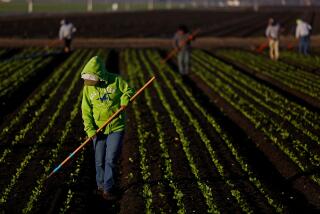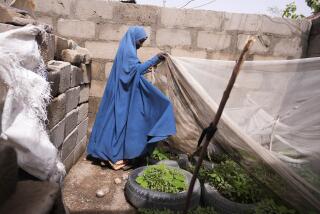‘We Had Live Aid’ : Hunger Proves an Elusive Lesson
- Share via
HAMILTON, N.Y. — A year later, the student’s question still disturbs philosophy professor Jeffrey Barker.
“Why do we have to study world hunger?” the student asked Barker, who teaches a course on “Contemporary Moral Problems,” including a unit on hunger, at Albright College in Reading, Pa. “We’ve already solved that problem. We had Live Aid. It’s no longer in the news.”
Barker’s anecdote became a favorite at a conference on how to teach undergraduates about world hunger held at Colgate University this month. It drew 68 college professors from 50 schools in 21 states.
The student’s question also illustrated two sad truths. Apart from attending benefit concerts like “Live Aid,” which sent millions of dollars to starving African nations in 1985, American students seem barely aware of world hunger and where and why it occurs. And most colleges do little to end that ignorance.
Swap Lesson Ideas
The conference enabled college professors to swap lesson ideas, such as assigning students to spend only a dollar a day on food to experience how poor people have to stretch their money.
They also got firsthand reports on food problems and solutions in Ethiopia, India and other hungry nations, presented by veteran relief workers from eight religious organizations.
Frank Conlon, program director for Africa with Lutheran World Relief, showed how simple technologies are helping West Africans survive: animal power harnessed for irrigation, cow manure turned into natural gas to fuel stoves and lanterns, special ditches dug to keep goats from gardens.
Alan Berg, nutrition adviser to the World Bank, told of the baffling insistence of Javanese mothers to nurse their infants only with their left breasts, which commonly leads to malnutrition.
Such hard realities of other countries’ efforts to feed their people seldom reach college classrooms in the United States.
Need More Information
“Step 1 is information--many of my students don’t even know where these countries are,” Barker said.
“Hunger at the college level is dealt with by taking walkathons or swims. We’ve let hunger on campus but not in the classroom. We want it in the official curriculum,” said Msgr. Robert J. Coll, executive director of Interfaith Hunger Appeal, a New York-based umbrella organization representing Roman Catholic, Protestant and Jewish relief services that co-sponsored the meeting with Colgate.
The point of such courses is not to create legions of altruistic student volunteers flocking to Third World countries. “Hunger field work is no place for amateurs,” Coll said. “It’s expensive and it’s dangerous.”
What is needed, said Coll and other conference organizers, is activism steeped in knowledge of how U.S. corporate and governmental policies affect hungry nations, sometimes for the worse.
“I’m not training Peace Corps volunteers. I’m training citizens of the world,” said Gary Larson, himself a former Peace Corps worker in Gambia who now teaches biology at Bethany College in West Virginia.
Universities as Culprits
Such courses should also lead students and teachers to ponder that universities may themselves be culprits in worsening world hunger, said Jack Kloppenburg, a rural sociologist from the University of Wisconsin.
Kloppenburg gave an example: university and corporate biotechnologists have collaborated for years to develop heartier seeds for various crops, and they have often gathered rare varieties from Third World countries. They claim that such genetic resources are mankind’s “common heritage,” like the air we breathe, and resist the idea that countries should be compensated for those resources. But the companies eventually turn around and claim patent rights and make hefty profits from the resulting products.
“It is hardly surprising that (less developed countries) see an asymmetry --exploitation, gene robbery,” Kloppenburg said.
Conference participants stressed that the teaching solution was not as simple as concocting new courses titled “Hunger 101.” Faculty members, especially younger ones with no tenure, could risk their careers by pushing for courses that do not fit neatly into academic departments.
Larson said a course he is planning at Bethany College next spring, which will examine nutrition around the world, may not earn him favor at his school.
Seen as ‘Oddball’
“I may now be looked upon as an oddball in my biology department for teaching out of my field,” he said.
“And the other problem is, how am I going to present the subject of world hunger to kids who are paying $12,000 a year and whom I’m supposed to be equipping for the jungles of New York or medical school? I have to work this through, so as not to overemphasize it, but to make students more aware of the world and how to solve a problem,” Larson said.
There is no shortage of literature on hunger. The conference displayed more than 100 books and a dozen periodicals on the subject. But the plentiful information means little unless a department head or dean backs a new course with time and money.
Many agreed that world hunger lends itself to an interdisciplinary approach: Teachers from 22 disciplines were represented at the Colgate conference, including social and natural scientists, philosophers, geographers and historians.
“I taught what I believe was the first interdisciplinary course on world hunger at MIT in the 1970s, and I would never have believed a gathering like this would have been possible,” Berg said.
School Size a Factor
Along with a biologist and philosopher, geographer Ellen Kraly at Colgate has taught a senior-level course called “World Food and Hunger” for two years. But she doubts that she could have done that in a larger school where she might have had to deal with two or three deans.
“As an educator, it depends on the type of institution. We can do different things at Colgate than at larger institutions,” she said.
An interdisciplinary course taught by a biologist and a philosopher, for example, might delve into the scientific and technical issues of hunger while raising the ethical question of whether there is any moral obligation to help the hungry.
“I mainly want students to clarify their positions,” Barker said. “When they do, I think the overwhelming evidence will lead to activism. That’s my goal. It’s mainly a question of whether working with the hunger problem is a moral obligation, rather than just charity.”
More to Read
Sign up for Essential California
The most important California stories and recommendations in your inbox every morning.
You may occasionally receive promotional content from the Los Angeles Times.










